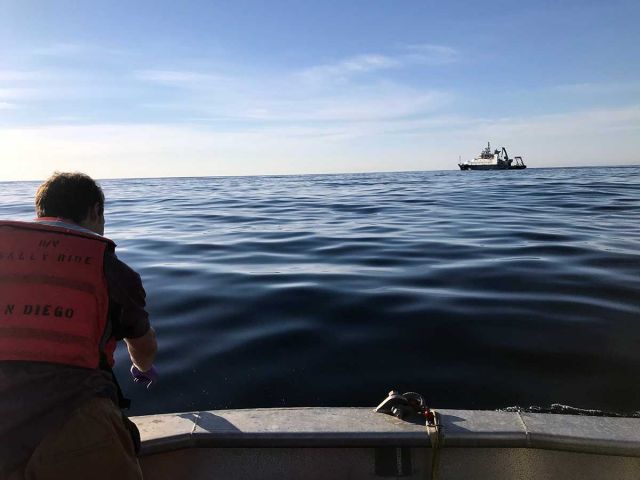Are Southern California wildfires a threat to local marine life?
A rare study on how the recent, massive wildfires could affect the nutrient-rich waters off Ventura County is underway by Southern California graduate students who just ended a weeklong expedition in the Santa Barbara Channel.

“We are examining the effects of ash on the very base of the ocean ecosystem: the phytoplankton, bacteria, and the small organisms that eat them,” said David Valentine, professor of Earth Science and Biology at the University of California, Santa Barbara.
“We are looking to see if the ash serves as a fertilizer or is toxic to these different groups,” he added.
The team of scientists was lead by UCSB doctoral students Kelsey Bisson and Nicholas Huynh, who had previously been awarded ship time aboard the Sally Ride, a 238-foot research vessel owned by the U.S. Navy and operated by Scripps Institution of Oceanography at the University of California San Diego.
Samples were collected from the waters off the mainland and around the Channel Islands, mainly in the center area of the Santa Barbara Channel, Valentine said.
The study was initiated because of the amount of ash that had fallen across the region. Oceanographers wondered what the soot and embers might do when it fell on the ocean’s surface, Valentine noted.
The Thomas fire in Ventura County, the Creek fire in and around Sylmar, the Rye fire in Santa Clarita and the Skirball fire near Bel-Air together scorched and traumatized almost 300,000 of acres of land and brush and sent smoke and pollution into the air. Hundreds of homes were destroyed as well. Floods and mudslides are feared for those areas, but it’s the coastline and Pacific Ocean, particularly around the Channel Islands, and the marine life there that could remain threatened.
A study published in Science magazine found that tropical wildfires in Indonesia affected the coral reefs and marine life around them. The nutrient rich runoff from the wildfires fed and encouraged large algal blooms that swallowed up oxygen, smothering and fish and coral.
“The proposed link between the death of the and Mentawai Islands reef ecosystem and the 1997 Indonesian wildfires has implications for the future health of coral reefs,” according to the authors of the study, published in 2006. “Widespread tropical wildfire is a recent phenomenon, the magnitude and frequency of which are increasing as population rises and terrestrial biomass continues to be disrupted. Therefore, in addition to their impact on forest ecology and human health, tropical wildfires may pose a new threat to coastal marine ecosystems that could escalate into the 21st century,”
Known as the “Galapagos of North America,” the five, remote islands off the Ventura County coast are surrounded by waters that hide imposing kelp forests and rocky reefs below the surface, according to a description from the National Park Service. The kelp and reefs provide shelter to more than 1,000 species of animals and plants, researchers and observers have noted. Pods of dolphins, seals and sea lions feed in the waters of the Santa Barbara Channel.
Valentine said he was unaware of any such local study, especially one in which scientists were able to respond so quickly. Out on the ocean, the team made several early observations, such as burnt leaves on the surface. But it’s too early to make any conclusions, Valentine cautioned.
“Our first activities, even before staring the expedition, have been to understand the physical and chemical behavior of ash when it falls on sea water,” he said. “We studied the material that leached from the ash, as well as the physical behavior of the ash in sea water. This enabled our understanding of what was likely to happen in the ocean: some ash floats, some sinks, and lots of material leaches from the ash.”